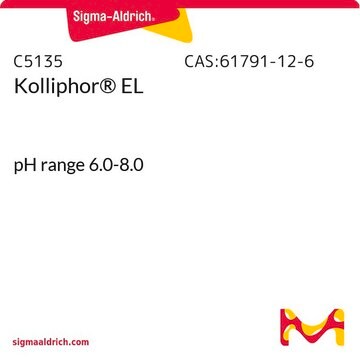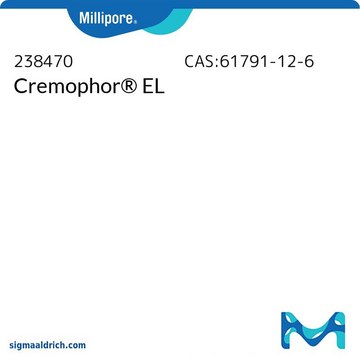32211
Chloroform
puriss. p.a., reag. ISO, reag. Ph. Eur., 99.0-99.4% (GC)
Synonym(s):
Methylidyne trichloride, Trichloromethane
About This Item
Recommended Products
Agency
USP/NF
reag. ISO
reag. Ph. Eur.
Quality Level
vapor density
4.1 (vs air)
vapor pressure
160 mmHg ( 20 °C)
grade
puriss. p.a.
Assay
99.0-99.4% (GC)
form
liquid
contains
~1% ethanol as stabilizer
technique(s)
RNA extraction: suitable
impurities
≤0.00001% free chlorine (Cl)
≤0.00005% free acid (as HCl)
≤0.0005% non-volatile matter
≤0.005% aldehydes and ketones (as CH3COCH3)
≤0.005% carbonyl compounds (as CO)
≤0.01% tetrachloroethene (GC)
≤0.01% tetrachloromethane (GC)
≤0.01% trichloroethene (GC)
≤0.01% water (Karl Fischer)
≤0.03% dichloromethane (GC)
0.6-1.0% ethanol (GC)
refractive index
n20/D 1.445 (lit.)
bp
60.5-61.5 °C (lit.)
mp
−63 °C (lit.)
density
1.476-1.483 g/mL at 20 °C
1.492 g/mL at 25 °C (lit.)
anion traces
chloride (Cl-): ≤1 mg/kg
cation traces
Al: ≤0.5 mg/kg
B: ≤0.02 mg/kg
Ba: ≤0.1 mg/kg
Ca: ≤0.5 mg/kg
Cd: ≤0.05 mg/kg
Co: ≤0.02 mg/kg
Cr: ≤0.02 mg/kg
Cu: ≤0.02 mg/kg
Fe: ≤0.1 mg/kg
Mg: ≤0.1 mg/kg
Mn: ≤0.02 mg/kg
Ni: ≤0.02 mg/kg
Pb: ≤0.05 mg/kg
Sn: ≤0.1 mg/kg
Zn: ≤0.1 mg/kg
SMILES string
ClC(Cl)Cl
suitability
complies for appearance
complies for reaction against H2SO4
complies for suitability of determ. w. dithizone
InChI
1S/CHCl3/c2-1(3)4/h1H
InChI key
HEDRZPFGACZZDS-UHFFFAOYSA-N
Looking for similar products? Visit Product Comparison Guide
Related Categories
General description
Application
- Extraction of RNA from plant cells.
- Preparation of dioleoylphosphatidylcholine (DOPC) solution.
- Dissolution of 1,2-distearoyl-sn-glycero-3-phosphocholine (DSPC).
Other Notes
Chloroform Miscibility/Immiscibility Table
The article number 32211-4X2.5L-M will be discontinued. Please order the single bottle 32211-2.5L-M which is physically identical with the same exact specifications.
The article number 32211-6X1L will be discontinued. Please order the single bottle 32211-1L which is physically identical with the same exact specifications.
The article number 32211-6X1L-M will be discontinued. Please order the single bottle 32211-1L-M which is physically identical with the same exact specifications.
Signal Word
Danger
Hazard Statements
Precautionary Statements
Hazard Classifications
Acute Tox. 3 Inhalation - Acute Tox. 4 Oral - Carc. 2 - Eye Irrit. 2 - Repr. 2 - Skin Irrit. 2 - STOT RE 1 Oral - STOT SE 3
Target Organs
Central nervous system, Liver,Kidney
Storage Class Code
6.1D - Non-combustible acute toxic Cat.3 / toxic hazardous materials or hazardous materials causing chronic effects
WGK
WGK 3
Flash Point(F)
does not flash
Flash Point(C)
does not flash
Regulatory Listings
Regulatory Listings are mainly provided for chemical products. Only limited information can be provided here for non-chemical products. No entry means none of the components are listed. It is the user’s obligation to ensure the safe and legal use of the product.
PRTR
Class I Designated Chemical Substances
ISHL Indicated Name
Substances Subject to be Indicated Names
ISHL Notified Names
Substances Subject to be Notified Names
JAN Code
32211S-4X2.5L:4548173257037
32211-195L-D:
32211-6X1L:4548173256962
32211S-1L:4548173257013
32211JP-6X1L:4548173257006
32211-2.5L-C:
32211S-2.5L:4548173257020
32211E-1L:
32211-144X1L-D:
32211-195L:4548173256870
32211S-6X1L:4548173257044
32211-1L:4548173256887
32211-2.5L:4548173256894
32211-7L:4548173256986
32211-45L-D:
32211JP-4X2.5L:4548173256993
32211-25KG:4548173256917
32211-4X2.5L:4548173256955
32211-25KG-D:
32211-25L-C:
32211-18L:4548173256863
32211-40KG-D:
32211-72X2.5L:4548173256979
32211-250KG:4548173256900
32211-40KG:4548173256931
32211-BULK:
32211E-6X1L:
32211-250KG-D:
32211-45L:4548173256948
32211-25L:4548173256924
32211-144X1L:
32211-VAR:
32211-25L-D:
Certificates of Analysis (COA)
Search for Certificates of Analysis (COA) by entering the products Lot/Batch Number. Lot and Batch Numbers can be found on a product’s label following the words ‘Lot’ or ‘Batch’.
Already Own This Product?
Find documentation for the products that you have recently purchased in the Document Library.
Customers Also Viewed
Our team of scientists has experience in all areas of research including Life Science, Material Science, Chemical Synthesis, Chromatography, Analytical and many others.
Contact Technical Service










